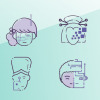Related Content
 |
How Embracing Differences Makes More Robust Agile Teams On any team, there are bound to be some differences. But even though work styles may differ from what you expect, they may not be problematic simply because they are different. Before making assumptions about what a teammate is doing or why, just ask to find out. Their differences may bring a helpful new perspective. |
|
 |
Creating a Community of Testers Many teams are divided by product or feature, with only one dedicated tester per team. How do you learn and grow in your career when you’re disconnected from your peers? One solution is to create your own community of testers that spans the organization. Here are some ideas to start and facilitate a Quality Guild. |
|
 |
Key Enablers for Continuous Testing Continuous testing means testing before, during, and after each software change is made. Testers have long advocated for this, but DevOps has made it more popular by pushing for rapid feedback and shifting testing left in the lifecycle. Here are three practices your company should embrace to enable continuous testing. |
|
 |
Designing Data Models for Self-Documented Tests When testing applications, documenting and interpreting test results can be a challenge. Data models enable us to collect and process test data more dynamically and uniformly. To design effective data models for self-documented tests, there are three important things to consider: what to document, collect, and report. |
|
 |
Change Is Hard, but BDD Is Worth It Behavior-driven development is a methodology change that impacts the whole team, and unfortunately, it’s not as easy as writing scenarios in a specific format. What is the added value of BDD? Why should the team throw their current process out the window and try to incorporate a new methodology? Here are some reasons. |
|
 |
When Field Testing Isn’t Possible, Use Simulation Field testing is great for discovering different situations, but due to a variety of constraints, it may not always be possible. In such cases, simulation is useful to create a picture that mimics the real scenario. You can replicate hardware, operating systems, network ranges, and more, as well as nonfunctional areas. |
|
 |
Using Design Thinking to Create Better Test Cases Design thinking is a user-centric framework to solve a business challenge by delivering the best user experience. Using design thinking, you can better frame the business drivers, select the right persona to focus on, design your user journey, identify test scenarios, pinpoint user pains, and write better test cases. |
|
 |
Building Culturally Inclusive AI Models For us to build the most effective technology, we need to learn from our past and build our future with more comprehensive data sets with cultural intelligence. This means AI that recognizes your story, chatbots that speak to you more authentically, and smart assistants that have inclusive data about your ancestry. |








